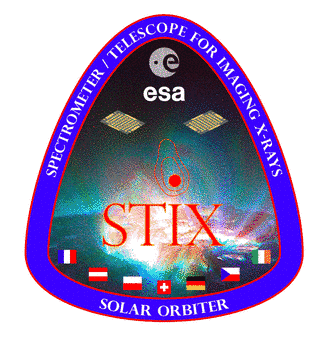 STIX will provide imaging spectroscopy of solar thermal and non-thermal X-ray emission from about 4 to 150 keV with good spectral
resolution and unprecedented sensitivity and spatial resolution (near perihelion). It plays an important role in enabling Solar Orbiter to achieve two of its major science goals of:
STIX will provide imaging spectroscopy of solar thermal and non-thermal X-ray emission from about 4 to 150 keV with good spectral
resolution and unprecedented sensitivity and spatial resolution (near perihelion). It plays an important role in enabling Solar Orbiter to achieve two of its major science goals of:
- determining the magnetic connection of the Solar Orbiter back to the Sun and
- understanding the acceleration of electrons at the Sun and their transport into interplanetary space.
![]() The international team developing the spectrometer consists of the scientists and engineers of numerous institutes from Switzerland, Germany, USA, Poland, Czech Republic and France. Konrad Skup is Co-I of instrument STIX. Piotr Orleański is STIX System Engineer.
The international team developing the spectrometer consists of the scientists and engineers of numerous institutes from Switzerland, Germany, USA, Poland, Czech Republic and France. Konrad Skup is Co-I of instrument STIX. Piotr Orleański is STIX System Engineer.
![]() Polish activities in SRC include Instrument Data Processing Unit, Instrument EGSE and Instrument Thermal Modelling.
Polish activities in SRC include Instrument Data Processing Unit, Instrument EGSE and Instrument Thermal Modelling.
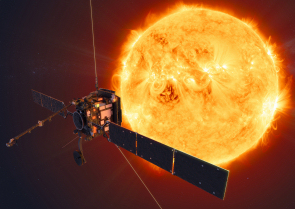
![]() ESA's Solar Orbiter mission lifted off on an Atlas V 411 from Cape Canaveral, Florida, at 05:03 CET on 10 February 2020 on its mission to study the Sun from new perspectives. About 90 minutes later, mission controllers at the European Space Operations Centre in Darmstadt, Germany, received a signal from the spacecraft indicating that its solar panels had successfully deployed.
ESA's Solar Orbiter mission lifted off on an Atlas V 411 from Cape Canaveral, Florida, at 05:03 CET on 10 February 2020 on its mission to study the Sun from new perspectives. About 90 minutes later, mission controllers at the European Space Operations Centre in Darmstadt, Germany, received a signal from the spacecraft indicating that its solar panels had successfully deployed.
In the first two days after launch, Solar Orbiter will deploy its instrument boom and several antennas that will communicate with Earth and gather scientific data. Solar Orbiter is on a unique trajectory that will allow its comprehensive set of instruments to provide humanity with the first-ever images of the Sun's poles. This trajectory includes 22 close approaches to the Sun, bringing the spacecraft within the orbit of Mercury to study the Sun and its influence on space.
Among a few instrument, STIX X-ray telescope is onboard, developed with a large participation of our team of engineers. The telescope will deliver up to ten high-resolution images of the Sun per second, which will allow to pinpoint precisely when and from which region on our Star, electrons have been broadcast into the interplanetary space.
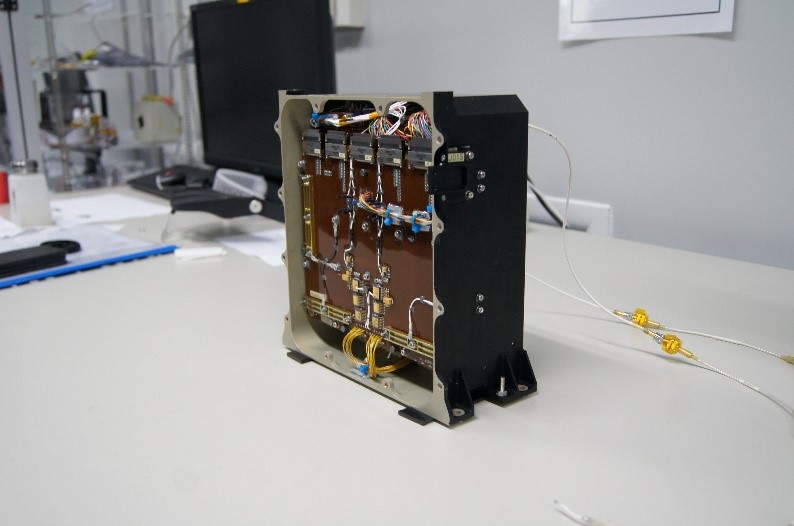
![]() In 2018 the main work in our lab was related to finalize manufacturing of the IDPU flight spare model, its integration with PSU into IDPU Box FS. Finally the integrated IDPU Box Fs was delivered to PI in Switzerland and integrated with rest of the STIX flight spare instrument.
In 2018 the main work in our lab was related to finalize manufacturing of the IDPU flight spare model, its integration with PSU into IDPU Box FS. Finally the integrated IDPU Box Fs was delivered to PI in Switzerland and integrated with rest of the STIX flight spare instrument.
![]() The 2018 activities in STIX on science and EGSE were performed in CBK Solar Physics Group in Wrocław.
The 2018 activities in STIX on science and EGSE were performed in CBK Solar Physics Group in Wrocław.
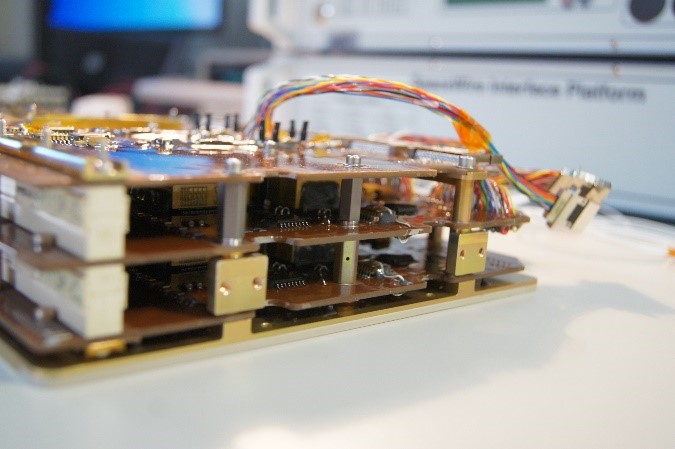
![]() The main work on phase C/D in 2017 was related to finalize manufacturing of the IDPU flight model, its integration with PSU into IDPU Box. Finally the integrated IDPU Box FM was delivered to PI in Switzerland and integrated with rest of the STIX instrument.
The main work on phase C/D in 2017 was related to finalize manufacturing of the IDPU flight model, its integration with PSU into IDPU Box. Finally the integrated IDPU Box FM was delivered to PI in Switzerland and integrated with rest of the STIX instrument.
![]() At the beginning of the year CBK engineers performed functional tests at assembly house to assure the components were installed properly. Afterwards the flight Boot SW was programmed into IDPU EEPROM memory. After the assembly finalization IDPU FM was delivered to CBK. Using the CBK facilities and prepared test environment engineers were able to perform tests needed to assure the IDPU FM works properly under different conditions and it can be delivered to the PI. Meantime the PSM FM was received and tested. Finally the IDPU FM and PSU FM were integrated at CBK into a common mechanical frame. The integrated subsystems were called from this point IDPU Box FM.
At the beginning of the year CBK engineers performed functional tests at assembly house to assure the components were installed properly. Afterwards the flight Boot SW was programmed into IDPU EEPROM memory. After the assembly finalization IDPU FM was delivered to CBK. Using the CBK facilities and prepared test environment engineers were able to perform tests needed to assure the IDPU FM works properly under different conditions and it can be delivered to the PI. Meantime the PSM FM was received and tested. Finally the IDPU FM and PSU FM were integrated at CBK into a common mechanical frame. The integrated subsystems were called from this point IDPU Box FM.
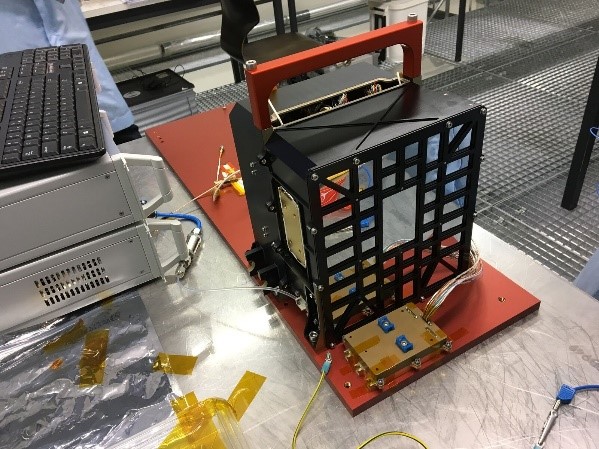
![]() The IDPU Box FM was post-integration tested and delivered to the PI in Switzerland. The IDPU Box FM was checked and tested in frame of incoming inspection. Next it was integrated with Detector Box FM creating the DEM Box FM. The DEM, after functional and environmental tests was integrated with Imager that included Aspect System (see right), creating the STIX instrument. The instrument then was delivered to ESA and integrated into the Solar Orbiter spacecraft. The spacecraft itself is under tests campaign.
The IDPU Box FM was post-integration tested and delivered to the PI in Switzerland. The IDPU Box FM was checked and tested in frame of incoming inspection. Next it was integrated with Detector Box FM creating the DEM Box FM. The DEM, after functional and environmental tests was integrated with Imager that included Aspect System (see right), creating the STIX instrument. The instrument then was delivered to ESA and integrated into the Solar Orbiter spacecraft. The spacecraft itself is under tests campaign.
![]() Beside of work on IDPU, CBK engineers also finalized manufacturing of STIX Aspect System flight and spare models. After testing, the Aspect System FM was delivered to the PI together with IDPU Box FM.
Currently the work concentrates on finalizing assembly of the IDPU FS. The Aspect System FS model is at CBK.
Beside of work on IDPU, CBK engineers also finalized manufacturing of STIX Aspect System flight and spare models. After testing, the Aspect System FM was delivered to the PI together with IDPU Box FM.
Currently the work concentrates on finalizing assembly of the IDPU FS. The Aspect System FS model is at CBK.
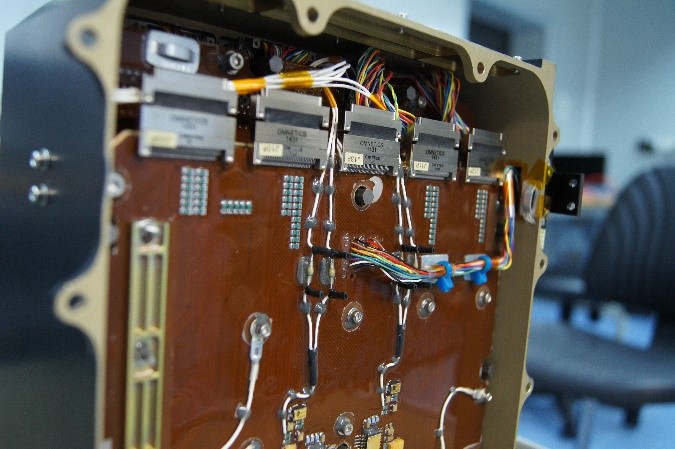 IDPU FM integrated |
 IDPU FM |
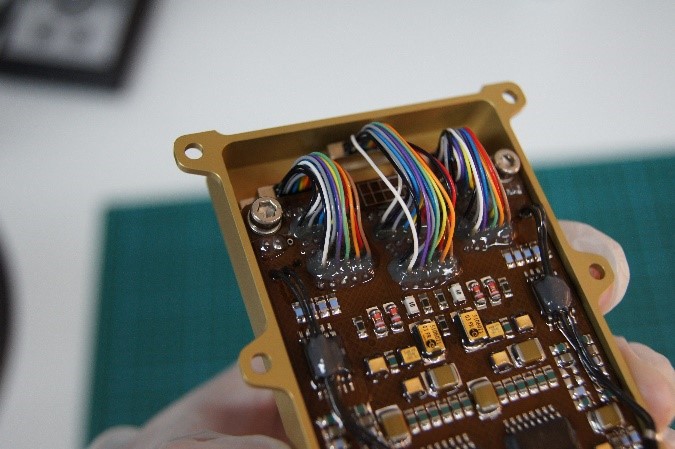 STIX Aspect System FM |
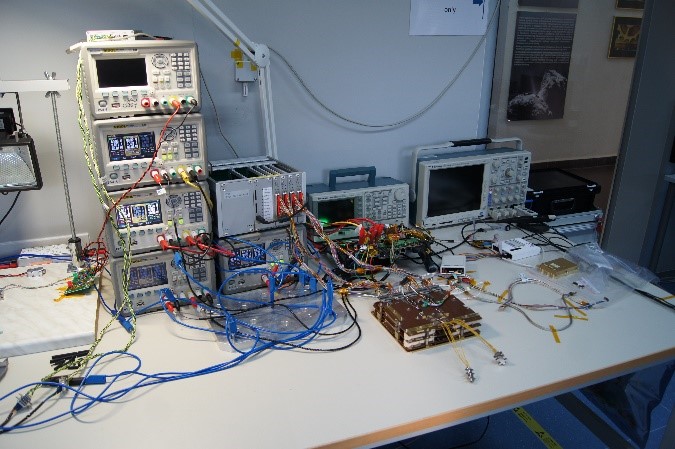 CBK test setup |

![]() The work on phase C/D was continued through whole year 2016. The main activity was related to finalize a design of flight IDPU schematics, PCBs layouts and the FPGA core. To perform these activities an IDPU AX model and automatic test environment were built and connected. Using this setup CBK engineers were able to confirm that a proposed IDPU concept is working properly. Based on these results the flight IDPU PCBs were sent for manufacturing. After receiving the PCB the assembly of the IDPU was started.
The work on phase C/D was continued through whole year 2016. The main activity was related to finalize a design of flight IDPU schematics, PCBs layouts and the FPGA core. To perform these activities an IDPU AX model and automatic test environment were built and connected. Using this setup CBK engineers were able to confirm that a proposed IDPU concept is working properly. Based on these results the flight IDPU PCBs were sent for manufacturing. After receiving the PCB the assembly of the IDPU was started.

![]() In parallel to electrical design, a work on FPGA verification and testing was done. Several simulations and tests performed on AX allowed to correct all identified errors. Finally two flight IDPU RTAX FPGAs were programmed and delivered for the assembly. Additionally activities on finalizing implementation and testing of the software drivers were performed. The drivers were successfully tested on the final FPGA core and released.
In parallel to electrical design, a work on FPGA verification and testing was done. Several simulations and tests performed on AX allowed to correct all identified errors. Finally two flight IDPU RTAX FPGAs were programmed and delivered for the assembly. Additionally activities on finalizing implementation and testing of the software drivers were performed. The drivers were successfully tested on the final FPGA core and released.

![]() Beside of work on IDPU, CBK engineers also finalized a design of STIX Aspect System. The flight models of it and related harness with temperature sensors and diodes were prepared and assembled.
Beside of work on IDPU, CBK engineers also finalized a design of STIX Aspect System. The flight models of it and related harness with temperature sensors and diodes were prepared and assembled.
![]() IDPU development took place in 2015 in our Laboratory. The IDPU
Engineering Model (EM), together with the Power Supply Unit and the mechanical frame were delivered and integrated with the so-called
DetBox in Switzerland in May 2015. Software developed by the Space Research Centre PAS and Evolved Systems in the Czech Republic (ESC)
completed the EM.
IDPU development took place in 2015 in our Laboratory. The IDPU
Engineering Model (EM), together with the Power Supply Unit and the mechanical frame were delivered and integrated with the so-called
DetBox in Switzerland in May 2015. Software developed by the Space Research Centre PAS and Evolved Systems in the Czech Republic (ESC)
completed the EM.
![]() An additional model of IDPU (called IDPU SW) was developed in Poland to support the Flight Software team in the Czech Republic at software development activities. The IDPU FSW was integrated with the Power Supply Unit and delivered to ESC.
An additional model of IDPU (called IDPU SW) was developed in Poland to support the Flight Software team in the Czech Republic at software development activities. The IDPU FSW was integrated with the Power Supply Unit and delivered to ESC.
![]() Activities related to the preparation of the flight model were carried out in parallel. Electrical schematics and the core field-programmable gate array (FPGA) were updated to fix problems found during EM integration. At the time of writing, printed circuit board (PCB) layouts are being finalised. The mechanical frame was also updated
to support a new power supply unit design and provide fixation points for mechanical ground support equipment (MGSE).
Activities related to the preparation of the flight model were carried out in parallel. Electrical schematics and the core field-programmable gate array (FPGA) were updated to fix problems found during EM integration. At the time of writing, printed circuit board (PCB) layouts are being finalised. The mechanical frame was also updated
to support a new power supply unit design and provide fixation points for mechanical ground support equipment (MGSE).
![]() The activities in STIX on IDPU (software, hardware and AITV) in 2014 have been conducted in our Laboratory. A few prototypes of IDPU unit have been manufactured and delivered to Czech Republic and Switzerland. Two other full models have been produced for CBK PAN purposes. The final hardware for IDPU EM was integrated with PSU EM and mounted on mechanical frame. The software activities (CBK PAN and Evolved System from Czech Republic) are started in order to finalize EM model in 2015. The proposal for STIX PRODEX Contract for phase C/D of Polish activities has been agreed with ESDA (formally signed in January 2015).
The activities in STIX on IDPU (software, hardware and AITV) in 2014 have been conducted in our Laboratory. A few prototypes of IDPU unit have been manufactured and delivered to Czech Republic and Switzerland. Two other full models have been produced for CBK PAN purposes. The final hardware for IDPU EM was integrated with PSU EM and mounted on mechanical frame. The software activities (CBK PAN and Evolved System from Czech Republic) are started in order to finalize EM model in 2015. The proposal for STIX PRODEX Contract for phase C/D of Polish activities has been agreed with ESDA (formally signed in January 2015).
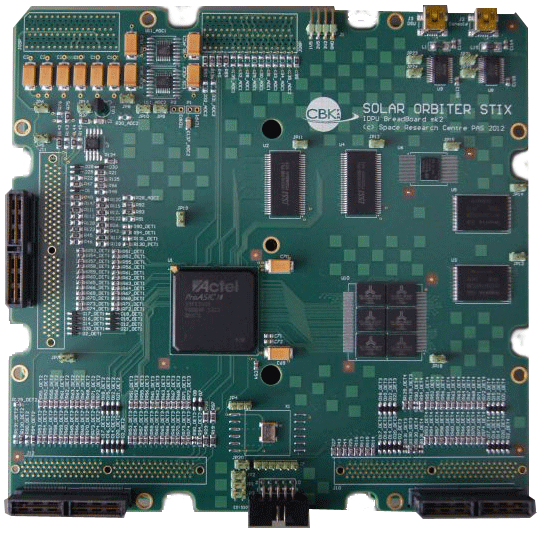
![]() In 2013 project work continued on preparation the basic software of IPDU. The breadboard module of IDPU has been delivered to Evolved System Company - ESC (Czech Republic) with the first version of BSW.
In 2013 project work continued on preparation the basic software of IPDU. The breadboard module of IDPU has been delivered to Evolved System Company - ESC (Czech Republic) with the first version of BSW.
![]() IDPU EM has been manufactured in 5 copies (one for software development at EvolvedSys, one for PSU tests at CSRC, one for Detector tests at AoT, two for SRC engineering activities). The electrical design, PCB layout and FPGA code have been validated based on this model. The mechanical and thermal designs of IDPU have been validated based on IDPU STM.
IDPU EM has been manufactured in 5 copies (one for software development at EvolvedSys, one for PSU tests at CSRC, one for Detector tests at AoT, two for SRC engineering activities). The electrical design, PCB layout and FPGA code have been validated based on this model. The mechanical and thermal designs of IDPU have been validated based on IDPU STM.
![]() The Full and Reduced Numerical Models (ESATAN) of whole STIX Instrument have been developed and delivered to ESA.
The Full and Reduced Numerical Models (ESATAN) of whole STIX Instrument have been developed and delivered to ESA.
![]() Aspect System Electronics design has been proposed and modeled. The first verification on breadboards are done.
Aspect System Electronics design has been proposed and modeled. The first verification on breadboards are done.
![]() DEM STM unit was finished. The unit is shown in the photos below: on left side there is unit manufactured in CBK, which has been delivered to Switzerland for an integration; the right photo shows the unit with integrated detector system.
DEM STM unit was finished. The unit is shown in the photos below: on left side there is unit manufactured in CBK, which has been delivered to Switzerland for an integration; the right photo shows the unit with integrated detector system.
 |
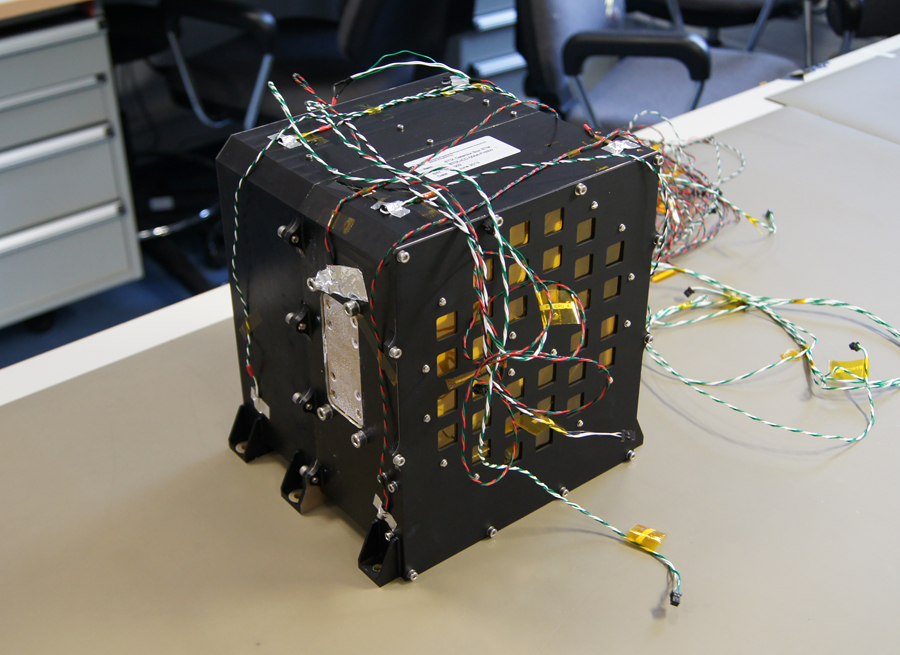 |
![]() "STIX team meeting" took place in CBK on 18-19 April 2013. The current status of STIX instrument was then discussed. Some final modifications and specific arrangements for selected interfaces and subsystems has been made during the numerous splinter meetings. In general 50 participants from 16 European centres were present in CBK, among them a representative of the ESA.
"STIX team meeting" took place in CBK on 18-19 April 2013. The current status of STIX instrument was then discussed. Some final modifications and specific arrangements for selected interfaces and subsystems has been made during the numerous splinter meetings. In general 50 participants from 16 European centres were present in CBK, among them a representative of the ESA.
 |
 |
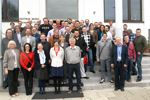 |
 |
![]() In 2012 IDPU Group focused on the different model/breadboards of IDPU and of the tests of such models with the prototypes of the detectors. The electrical and mechanical interfaces of IDPU have been agreed. The mechanical structure of IDPU Box (including IDPU and PSU) has been proposed. The activities on EM model on IDPU/STIX are well advanced.
In 2012 IDPU Group focused on the different model/breadboards of IDPU and of the tests of such models with the prototypes of the detectors. The electrical and mechanical interfaces of IDPU have been agreed. The mechanical structure of IDPU Box (including IDPU and PSU) has been proposed. The activities on EM model on IDPU/STIX are well advanced.
![]() The Flight Software for STIX instrument is designed in cooperation between CBK and Evolving Systems Consulting company from Czech Republic. The software will consists of three products: basic, start-up and application. Basic Flight SW is designed in CBK and two others in ESC. The requirements and the specifications for the Flight Software was agreed. Internal audits for Basic SW was performed and STIX PDR (Preliminary Design Review) was completed.
The Flight Software for STIX instrument is designed in cooperation between CBK and Evolving Systems Consulting company from Czech Republic. The software will consists of three products: basic, start-up and application. Basic Flight SW is designed in CBK and two others in ESC. The requirements and the specifications for the Flight Software was agreed. Internal audits for Basic SW was performed and STIX PDR (Preliminary Design Review) was completed.
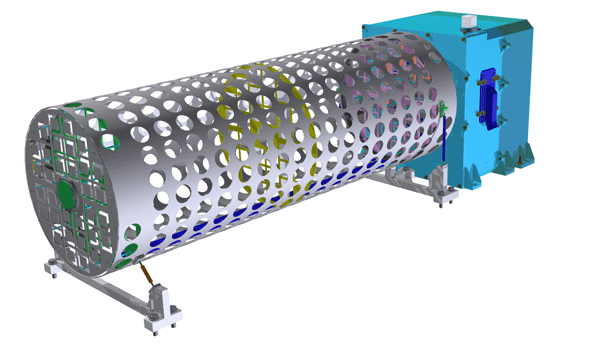 |
![]() In 2011 the phase B of STIX/SolarOrbiter Project has been finished. The first prototypes of the essential parts of the instruments have been built and tested. The whole set of documents used for STIX IDPR has been prepared.
In 2011 the phase B of STIX/SolarOrbiter Project has been finished. The first prototypes of the essential parts of the instruments have been built and tested. The whole set of documents used for STIX IDPR has been prepared.